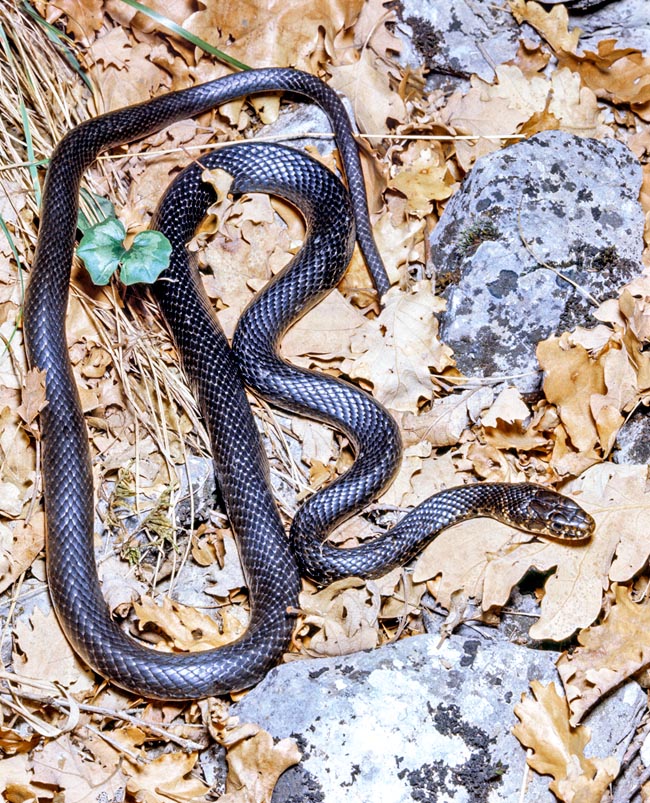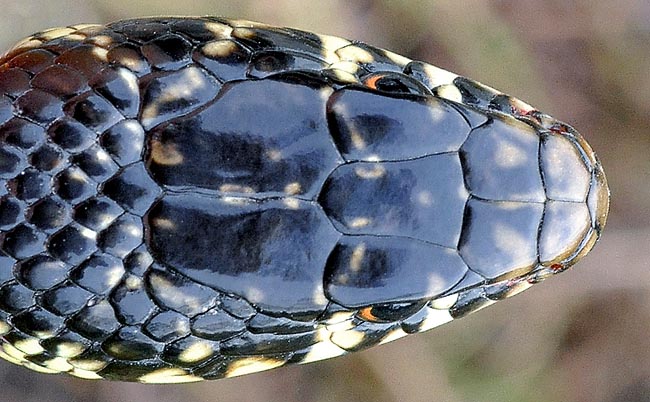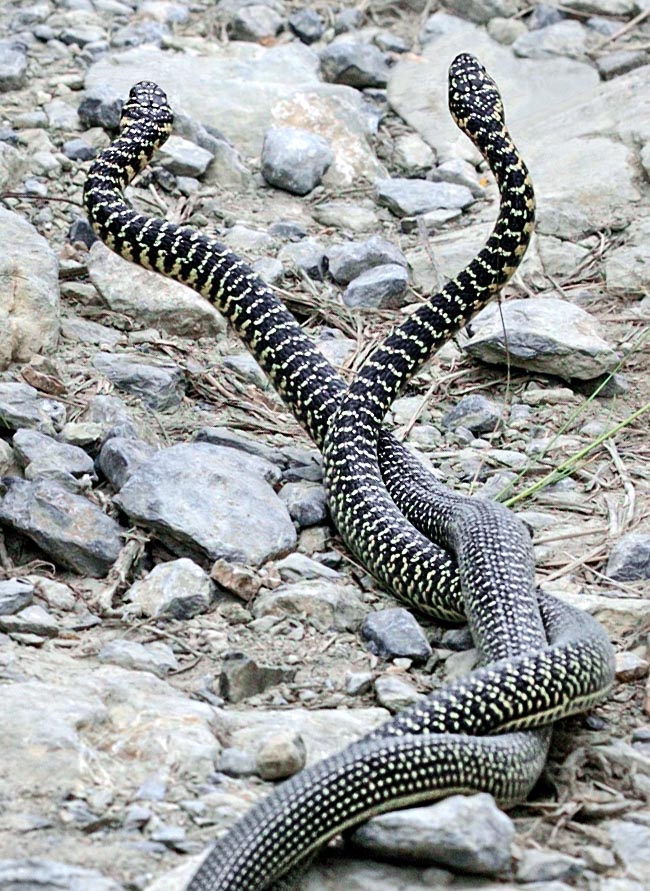Family : Colubridae

Text © Dr. Carlo Zucchi

English translation by Mario Beltramini

Mainly diffused in warm European regions, the Green whip snake has two phenotypes, the carbonarius, here shown, wholly black in the upper part of body and viridifilavus with greenish black patterns on pale yellowish background © Giuseppe Mazza
The Green Whip Snake (Hierophis viridiflavus Lacépède, 1789) is one of the most characteristic and frequent snakes in its distribution area.
The name of the genus Hierophis derives from the combination of two Breek terms: “ἱερός” ( hierós) = saint and ὄφις” ( óphis) = snake; whilst the specific term viridiflavus is the combination of the Latin adjectives “viridis, e” = green and “flavus, a, um” = blond, yellow; with reference to the white-yellowish and black-greenish colouration of its body.
Zoogeography
From the taxonomical point of view, after some Hierophis viridiflavus should be a monotypic species; after others a distinction should be done between the two subspecies.
In fact, looking at the livery, some talk of the subspecies Hierophis viridiflavus viridiflavus, that typical with the yellow and black colouration and greenish shades, opposed to the Hierophis viridiflavus carbonarius that they assign to the numerous specimens having black back.
Recent studies on the subject seem however to lean in favour to the monotypic thesis.
Apart the coldest zones, it is present in most of Europe, from the extreme north of Spain to the central-southern France and to Corsica; in southern Switzerland, all over Italy, Sicily, Sardinia and lesser islands included, in south-western Slovenia and Croatia (coastal zone and some islands).
In the past the population of the Greek island of Gyaros was considered as belonging to an endemic species (Coluber gyarosensis) but more in-depth analysis have ascertained that actually it concerns Hierophis viridiflavus introduced in historical times.
Ecology-Habitat
The green whip snake is a reptile typical to the ecotonal habitats, that is, zone of transition zones between two environments, with a preference for those with dry and warm climate.

Advances head-on to better observe the environment picking the odours with the tongue © Gianfranco Colombo
It can be found in almost all natural and semi-natural environments, like, for instance, the areas marginal to woods, clearings, open zones even if cultivated, areas rich of bushes and shrubs, fallows, screes, piles of wood, dry stone walls and also close to inhabited areas.
It is a typical terricolous snake, even if, when necessary, is able to climb for reaching the preys and to swim to escape predators or harrassments.
At times it can reach the 1500-2000 m of altitude, depending on the physical and biological characteristics.
It is greatly adaptable, diurnal and moving fast and with agility. While exploring its own territory it raises the fore part of the body to have a broader view and pick up better in the air, thanks to the continuous movement of the forked tongue that conveys to the Jaconson’s olfactory organ, the odorous particles that reveal the presence of possible preys or predators.
It is often seen while moving around looking for food or for a partner or while warming up in the sun in places not always suitable as are the paved roads that have invaded its world and where, unluckily, in exchange of the thermoregulation, it quite often meets the risk of being invested.
If cornered and with no escape route, it reveals its lively and aggressive character and does not hesitate in biting repeatedly.
Fright and possible infections apart, the man does not incur any risk as it is not a venomous reptile.
In relation to habitats the population density of the Green whip snake can be high, reaching the 10-12 individuals per hectare.
Each individual, when utilizing the territory, leaves from one “base” or “preferred site-shelter” and moves daily of about 200-300 m (even 3000 m during the reproductive time) exploring the surrounding zones.
The cycle of activity goes from March to October with obvious variations depending on the local conditions.
Morphophysiology
Hierophis viridiflavus is a 100-150 cm long snake, with agile and slender body. Its head is oblong, well distinct from the rest of the body. The eyes are big with round pupils and very long tail, thinned at the end.

Head particular. The shape and number of scales are a very important element for identification © G. Colombo
The sexual dimorphism in this species is relatively modest.
Usually the males are bigger than the females, with a more voluminous head for holding them firmly during the mating.
The head is longer but the trunk shorter if compared to the partners.
Furthermore, these last have a typical colouration, with more “muted” colour tones in respect to the males.
They have 1, occasionally 2, preocular scales; 1 subocular; 2 postocular (rarely 1 or 3); 8 (fourth and fifth in contact with the eye) labials superior; 10 labials inferior; rostral wider than tall: frontal longer than wide and wider than the supraoculars; big loreal; parietals longer than the frontal; 187-227 ventrals; anal scale divided; 95-124 subcaudals; 17-19 rows of smooth scales at half body.
The colouration viridiflavus is quite typical: whilst the lowest parts are white-yellowish, in the upper parts stands a background colour always whitish-yellowish but covered by a dark greenish-blackish pigmentation that forms bars or interlacings of spots.
Towards the back part of the body the bars become more regular to form, on the tail, dashed yellow lines on a dark background.

Typical terricolous, can climb, when needed, to seize the preys that it kills choking them by constriction. In case of danger it can also escape swimming © G. Colombo
The young and the immatures display on the head a livery similar to the adults, whilst the body has an elegant olive colour with dark brown spots. Conversely, the phenotype carbonarius is totally of carbon black colour on the upper part of the body.
Ethology-Reproductive Biology
Although decidedly aggressive, Hierophis viridiflavus is a totally harmless species: in fact it is not venomous and kills its preys by constriction. The diet of the adults is mainly formed by other reptiles such as lizards and snakes, amphibians, and in a lesser measure, by small mammals and birds, eggs included.

If obliged, it doesn’t hesitate to bite repeatedly the importunate, in this case a fisherman’s boot. It has no venom and is a species totally harmless for the man © Colombo
The young instead nourish mainly, as is the case for those of the Aesculapian snake (Zamenis longissimus), of small lizards and insects.
After a long period of winter inactivity, at times spent in the rural garrets or in the cellars, in March the Green whip snake is again active and by April/May the courting begin. This is the period when more frequently we can observe the ritual fights between males where the two individuals, clinging, try to throw down each other.

Two males of the phenotype viridiflavus in virtual fight. The strongest throws down the opponent conquering the territory and the females that immobilizes in turn for the coupling thanks to a bite on the neck © Giuseppe Mazza
Once the supremacy of the winner is recognized, the loser goes sadly away leaving the field and the females to the actual champion.
The male, found the female, wraps itself around it and immobilizes it with a bite on the neck then proceeding with calm to the copulation.
The deposition occurs by June-July, in holes of the ground, under heaps of stones or simply sheltered by the vegetation. Sometimes even in places frequented by the man such as hen houses and cellars.
Usually they are 10-20 oblong eggs, a pair of centimetres wide and three long.
Depending on the conditions of incubation they hatch after about 1,5-2 months and the newborns measure 20-25 cm.
In this period they closely resemble to those of the Ringed snake (Natrix natrix) and in the eastern part of its range the young my be mistaken with Hierophis gemonensis, a species that overlaps in part of the territory and from which they differ only for the lepidote characteristics (number and disposition of the scales) and for slight differences in the livery.
During the first weeks of life the young are subject to a strong mortality caused by the predators, not only big birds, poultry included, but also mice and even adults of the same species, notoriously cannibal.
They reach the sexual maturity on the fourth year of age.
Synonyms
Coluber gyarosensis, Mertens 1968; Coluber viridiflavus, Kahl et al. 1980.
→ For general notions about Serpentes please click here.
→ To appreciate the biodiversity within the SNAKES please click here.
We are looking for an author for this text.
Volunteers should contact me.
